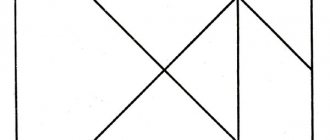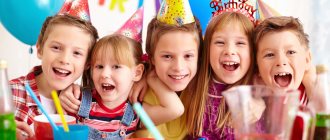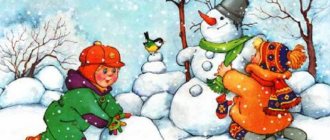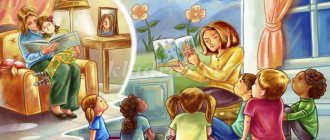Card file of physical education minutes in the senior group of kindergarten at the age of 5-6 years with goals according to the Federal State Educational Standard
Movement is of great importance for the full physical and mental development of children.
With a lack of physical activity, children experience problems with speech, and the processes of mental development slow down. In kindergarten, much attention is paid to the development of movement skills. The main means of this work are physical education classes.
At the same time, the dynamic component of various types of activities is also increased due to physical education minutes during classes, games and while walking.
The importance of physical education in the senior group of preschool educational institutions
Short breaks in the form of light physical activity are arranged between different types of activities for kindergarten students, as well as during work that involves intellectual concentration, for example, classes on speech development, the environment, mathematics, fine arts, etc. The duration of a physical education minute is usually 1 ,5–3 minutes. As a rule, it includes a set of 3-4 exercises, repeated several times and aimed at activating breathing and blood circulation.
. In some sources, physical education minutes are called physical education breaks, but these are somewhat different concepts. Thus, the pause time is somewhat longer than minutes and includes from 5 to 8 exercises.
The need for breaks is also evidenced by the fact that sometimes during classes the child begins to fidget in his chair, trying to change his position. This behavior is evidence of mental fatigue, and therefore decreased attention. If the type of activity is not changed, then the child’s back slouches, shoulders droop, blood circulation slows down, and as a result, posture disorders appear.
If preschoolers are tired, they start to get distracted
Goals
The goals of active breaks in the senior group are:
- increasing or stabilizing the performance of pupils during classes;
- providing short-term rest, especially for the organs of vision and hearing, which undergo heavy loads;
- creating conditions for relaxing the muscles of the back, torso, and hands.
. According to research by psychologists, pediatricians and teachers, for a child to fully develop, a change in activity should occur every 20 minutes.
Tasks
The objectives of physical education sessions with children 5–6 years old include:
- improved posture;
- increased metabolism;
- development of attention and memory;
- training the ability to concentrate;
- receiving sensory impressions;
- restoration of the emotional background.
Physical education sessions are an excellent means of preventing fatigue in older preschoolers.
Techniques
To achieve the set goals and objectives, the following techniques are used:
- rhymes, nursery rhymes illustrating warm-up movements;
- visualization (pictures, posters) showing the order of actions;
- a combination of different types of physical activity (tasks to work on the muscles of the arms, legs, torso, to stimulate the circulatory system, etc.).
For physical education, it is appropriate to combine:
- 3–5 exercises for the muscles of the arms, legs, shoulder girdle, torso;
- gymnastics for hands and fingers (gestures, working with special massage balls, nuts, etc.);
- walking, jumping.
Physical education combines movements of the arms, fingers, torso, etc.
Types and forms of physical education in the senior group of kindergarten
Short breaks to activate motor skills can be grouped into several types.
Their goal is to switch the attention of pupils from one type of activity to another. This not only improves the quality of material absorption, but also reduces the pressure on the child’s body. This type of break includes:
- stretching and straightening the spine;
- run;
- walking in place;
- squats;
- jumps;
- bending to the sides and swinging your arms.
Such tasks are performed accompanied by nursery rhymes, the heroes of which are mice, hamsters, bunnies, bears, etc. For example:
- The bear crawled out of the den and looked around at the threshold. (Perform turns left and right) To quickly gain strength, the bear's head twisted. (Rotate their head) Leaned back and forth, Here he is walking through the forest. (Bends forward and back) I approach the horizontal bar, take the crossbar, strain my muscles together, I want to be slender and strong! To become strong and agile, start training!
- Khomka, Khomka, Hamster, (Circular movements on the stomach) Striped flank. (Straight movements on the sides) The hamster gets up early, (Stretches) He washes his neck, (Imitates washing his neck) He rubs his cheeks. (Rubs his cheeks with his fists) Khomka removes the hut (Imitate sweeping) And goes out to exercise: (Walk in place) One, two, three, four, five (Arms forward, up, forward, to the sides, down) Khomka wants to become strong. (They show how strong Khoma is).
- It’s cold for the bunny to sit, You need to warm up your paws. Paws up, paws down, Pull yourself up on your toes, Put your paws on the side, Jump-hop-hop on your toes. And then squat down, So that your paws don’t freeze. The bunny is good at jumping, He jumped up ten times. (Children imitate all the movements described in the poem).
Preschoolers perceive story-based physical education lessons better
Physical exercises for fingers and hands
Such physical training sessions are carried out to relax muscles after prolonged work with pencils and pens. They are often used in writing or drawing classes. The set of exercises includes tasks on:
- flexion/extension of the hands;
- moving your wrists in a circle;
- tension and relaxation of the fists.
This type of warm-up includes, for example, the “Scarlet Flowers” warm-up:
- Our red flowers open their petals. (Unclench their fingers) The breeze breathes slightly, the petals sway. (Wiggle their fingers) Our red flowers close their petals. (Fingers clenched into a fist) They shake their heads, Quietly fall asleep. (They shake their fists).
Gymnastics for fingers activates the work of speech centers
They are used to stimulate the interest of preschoolers in performing familiar exercises, but in an unusual poetic or playful form. Essentially, this is the same set as for the first type of physical education lessons, held in the second half of classes, but only in form. also correlates with the theme of charging. Examples of exercises of this type:
- Pinocchio stretched, (Raises his arms upward from the sides, stretches, rising on his toes) Once - he bent over, Two - he bent over, (Tilts the body forward) Spread his arms to the side, (Arms spread out to the sides) The key, apparently, was not found. (Turns right and left) To get the key, we need to stand on our toes. (Hands on the belt, raised on tiptoes).
- The wind quietly shakes the maple, tilts to the right, to the left: Once - tilt and twice - tilt, The maple leaves rustled. (Feet shoulder-width apart, hands behind the head, body tilted to the right and left).
- The steam locomotive “Tu-tu” hummed (They put their hands on the shoulders of the child standing in front) And the carriages drove away. Chu-chu-chu, chu-chu-chu (“Steam locomotives” go in a circle) I’ll rock them far away. The locomotive shouts: “Doo-doo - duh, I’m walking, walking, walking.” And the wheels are knocking, And the wheels are saying: “Well, well, well!” (Walking in place, moving forward, with bent arms making movements back and forth).
Thematic physical education minutes are included in the set of exercises for exercises
Forms of taking breaks
Physical education lessons should be presented in a suitable form so that the children are interested in doing physical exercises. This:
- Tasks for general development. Include 3-4 exercises for all muscle groups, ending with jogging at a moderate pace in place or fast walking.
- Outdoor games. It is better to choose games of average mobility, without the requirement of large free areas and compliance with objectively simple rules.
- Didactic game. Suitable for use in speech development classes.
- Dance steps. Conducted in the middle of the lesson to music with a moderate rhythm.
- Movements accompanying the plot of the poem (riddles, nursery rhymes or counting rhymes). Texts must be selected with clear rhyme and clear content that resonates with the topic of the lesson. Most finger games are based on the text of a nursery rhyme or poem
- Illustrative movements, for example, guessing riddles not verbally, but by simulating motor activity: a speed skater (characteristically moves his legs), a boxer (swings his fists), etc.
Methodology for conducting physical education sessions in the senior group
As a rule, signs of fatigue in students of older groups appear at 12–15 minutes of class. Physical education sessions are held within this time frame.
. Very young participants in the educational process in kindergarten begin to get tired at 7-9 minutes of class, and children in the middle group - at 10-12 minutes.
Rules
In order for each methodological component to fulfill its role, it is necessary to adhere to the following recommendations:
- Before completing the task, you need to discuss with the guys what is being discussed in the physical education lesson, and perform all the movements at a slow pace.
- The essence of the task should be simple and understandable to children.
- You need to perform all the movements (including singing along) in parallel with the students, while showing enthusiasm for the process. First, the teacher shows all the movements of the physical education lesson in slow motion, and the children repeat
- The text of the physical education lesson should sound expressive, first anticipating the actions, and then illustrating them.
- Preschoolers should be praised for completing all stages of preparation, even if they make mistakes due to inexperience.
- breaks vary depending on the topic of the lesson in which physical education is performed.
- If the guys are passionate about something, then there is no need to distract them, otherwise it will not be easy for them to return to the working rhythm. It is better to give the opportunity to finish what you started and then take a break.
Table: card index of thematic physical education minutes (compiled based on open access materials)
Balls, plumes and other equipment can be used as attributes of physical education sessions.
: example of physical education in the senior group
Physical education sessions in kindergarten help strengthen and maintain the health of preschoolers. At the same time, they also carry the important mission of maintaining students’ interest in educational activities. Such short-term rest in the form of a change of classes allows children 5–6 years old to work productively throughout the day, which prepares them for their future school life.
Source: https://melkie.net/zanyatiya-s-detmi/kartoteka-fizkultminutok-v-starshey-gruppe.html
Developing the hands
It is known that at first it is quite difficult for preschool children to learn to hold a pencil, brush or felt-tip pen in their hand, and also to use them correctly. Toddlers are unable to hold a pencil at all, and older children begin to squeeze it too tightly with their fingers when drawing - in this case, the small muscles of the arm and hand as a whole are overloaded. And here physical education also comes to the rescue, but not a simple one, but a finger one. It's best when it's accompanied by a funny poem.
Finger exercises are very useful for preschoolers
Guests
Masha began to call the guests: (Rotate her hands towards herself.) And Ivan come, and Stepan come, And Matvey come, and Sergei come, And Nikitushka - well, please. (Alternate massage of the fingertips of the right hand.) Masha began to treat the guests: Damn Ivan, Damn Stepan, Damn Matvey, Damn Sergei, And Nikitushka - mint gingerbread. (Alternate massage of the fingertips of the left hand.)
Two sisters
Two sisters, two hands, (Shaking hands.) They chop, build, dig, (We depict the words of the text in motion.) They pull weeds in the garden bed and wash each other. Two hands knead the dough - left and right, rake in the water of the sea and rivers while swimming.
"Advice. When working with preschool children, it is important to devote sufficient time to physical education based on exercises to develop fine coordination of hand movements. Such exercises prepare the hand for writing.”
Children's physical exercises
Physical training is a small set of exercises carried out in a playful way to relieve muscle fatigue and restore children’s performance. Physical training will help you relax, relieve tension, and improve blood circulation.
The name itself includes the duration of the dynamic pause: 1-2 minutes, during which children have the opportunity to change their body position, move around, and get a boost of energy, which has a beneficial effect on the development of the nervous system.
Children's physical education sessions are usually accompanied by short poems or short thematic stories encouraging the execution of movements. Thematic physical exercises with skillfully selected text help to increase interest in the lesson.
The proposed movements should not be complicated so that every child can cope with the proposed game with ease and pleasure.
There are many forms of physical training:
- outdoor game
- imitation game
- dance moves
- general developmental exercises
- facial exercises
- gymnastics for the eyes
- gymnastics for individual parts of the body
see also
Children's self-massage - health-saving technologies Prevention of flat feet - health-saving technologies Relaxation during physical education - health-saving technologies
EXAMPLES OF PHYSICAL MINUTE
Physical exercise “Smile”
And now we all stood up together Hands raised up in unison Hands to the sides, forward And now vice versa Turned left and right And smiled at each other Quietly sat down and we’ll be together again
Continue the work (draw a house, read our story...)
Physical exercise "Let's take flight"
Today you and I, children, are flying on a rocket. Hands up and pull yourself up. The rocket is flying straight up. Or maybe the plane will take all the children into flight? Flap the wing once, twice, three times, look at each other and fly again
Let's draw together (compose, count...)
Physical exercise "Fidget"
The fidget stretched, turned left and right, extended his arms, bent them
And quietly sat down on a chair
Physical exercise “If we get a little tired”
If we get a little tired Let's all stand up quietly together And clap our hands One two three four five Each time we will raise our arms higher And stomp our feet One two three four five Each time we will be with you Lower, squat lower Our legs are spinning One two three four five We are now ready again
Complete all tasks.
Physical exercise "Balls"
All the girls and boys Jump like balls One, two, three, four, five Keep your head up so your arms don’t get tired
We'll put them on our belts
Physical exercise “We really need to rest”
We will clap our hands We will stomp a little Shake our heads We should not be discouraged We will raise our hands And now we will sit down together We really need a rest We will clap our hands
And let's drown a little
Physical exercise “We live very friendly”
We live very friendly (shows thumb) We walk down the street (marching in place) If we are in a hurry, we will quickly run together (running in place) We will look around, see if everyone is running nearby (turns) If there is no one nearby we will look here and there (tilts) We haven’t lost anyone, all the guys are in place (inhale and exhale)
So we can continue to complete our task (they sit down)
Physical exercise “Don’t be lazy, work hard”
Together, hands on the side Don't clench your fist Hands up, you rise up Now clench your fists Unclench and squeeze it Quickly, quickly, you need to stand on your toes Our legs should be stretched by everyone Get down, get up Bend over together Don't be lazy, work hard Stand up straight again Put your hands on your side
Don't clench your fist
Physical exercise “Good mood”
All the guys stood up straight, Marching like soldiers, Hands up and hands down, Rise up on your toes, Rise up one more time, Smile at everyone, my friend, And in a good mood
Sit down at the table again
Physical exercise “Chick”
The bird flapped its wings (flapping its arms) turned its head (turning its head left and right) two - bent over the millet (bending forward to the floor) three - the bird returned to the house (arms above its head “roof”) A chick was waiting for her in the house, a loud-voiced daredevil,
Pee-pee-pee (pronounced in unison)
Physical school
Three tourists were returning along the path slowly (walking in place) The sun is shining brightly in the sky, (raise your hands up) And the weather is good (circular movements with your hands) Behind the hillock, near the forest Which is neither low nor high (sit down, stand up) Three tourists heard an unfamiliar voice ( hands to ears) You’ll find out who screamed in the forest
If you guess the voice (one of the children makes a sound, the rest guess)
Physical school
I’ll open my album (they spread their arms wide) There are so many drawings in it! This is a bunny (children jump) This is a gnome (children sit down) This is my beautiful house (they place their hands in a triangle above their head) Here in the album is an airplane (arms to the sides) Taking flight (circular movements with hands “motor”) I’ll close my album (clap hands)
I'll watch it later.
Physical school
Under the window near the garden The maples are lined up in a row (stand up) The wind plays with the maples (swings with raised arms) The maples rustle with leaves (circular movements with the hands) The wind never stops
Maples lean (forward bends)
Physical school
Jump and hop, jump and hop The bunny jumped onto a tree stump In the clearing near the bunny The animals gathered in a circle Having counted everyone in order The bunny suggested exercise One! Everyone jumps on the spot Two! Ears waving together Three! Everyone crouches together and everyone wags their tails. Four for everyone again.
Exercises to perform



